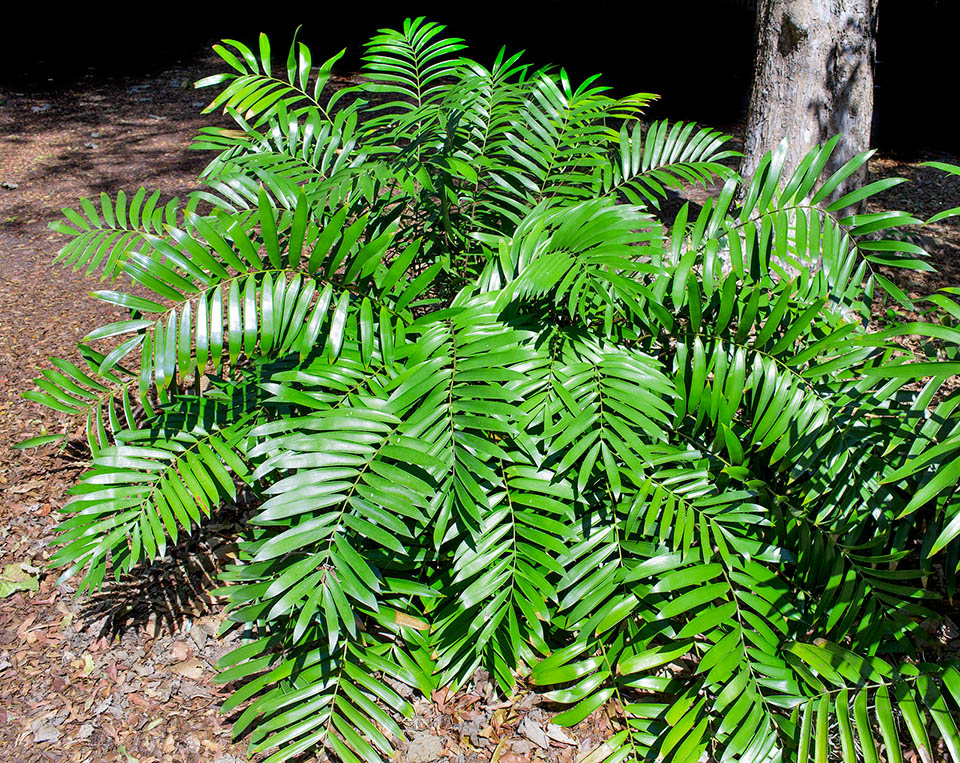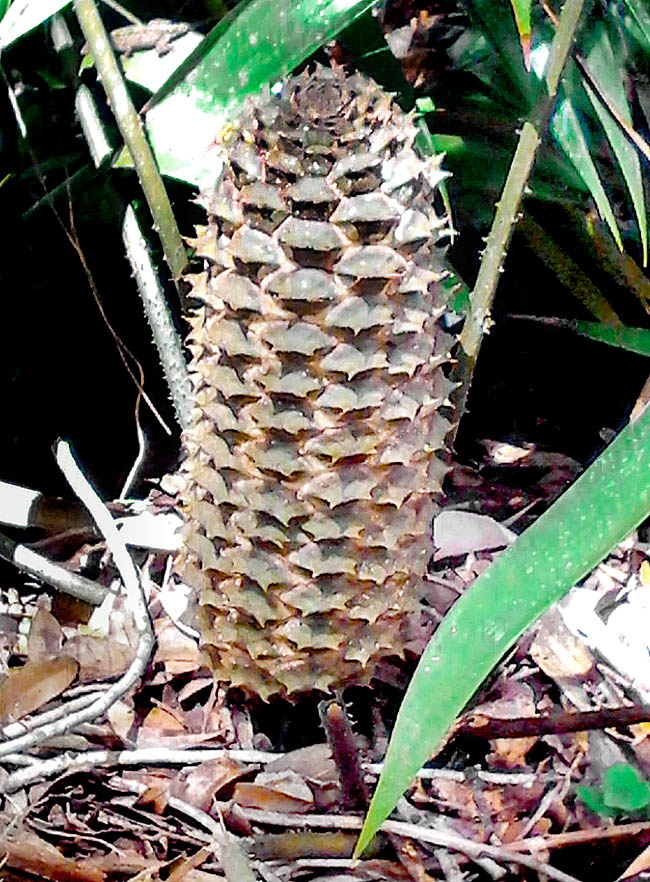Family : Zamiaceae

Text © Dr Claudio Littardi

English translation by Mario Beltramini
Ceratozamia latifolia Miquel (1848), is a species endemic to Mexico. The habitat is reported in territories close to San Luis Potosi and Hidalgo, in the south-eastern part of the mountain region of Querétaro, where the cycad thrives at about 850 m of altitude, in pluvial forests.
It grows among calcareous rocks, in humid and steep areas, where rain and fog are present even in the most dry winters. It lives in association with arboreal ferns, philodendra and other tropical plants. It can grow also in hollows along the rocks, where the humus settles, or on the trees, as arboricolous, thanks to the germination of seeds carried by birds or other animals that have nourished of the seed coat, the fleshy outer part of the integument of the seed.
The name of the genus Ceratozamia comes from the Greek “κέρας, -ατοϛ” (céras, cératos) = horns and “ἀζαίνω” (azaíno) or “ἀζάνω” (azáno) = cone, with reference to the characteristic reproductive structures that display sporophylls surmounted by two protuberances (horns), and cones that recall those of the conifers; the specific name latifolia comes from the Latin “latifolius”, to indicate broad leaf.

Easy to cultivate, also indoors, Ceratozamia latifolia is a species endemic to Mexico with very low stem and 50-150 cm leaves © Giuseppe Mazza
It is a plant with very low stem, acaulescent, even if in the oldest specimens it can emerge from the soil, for about 12-25 cm, with a diametre of 10-12 cm. The stem is covered by persistent cataphylls, of reddish brown colour, partially tomentose and of triangular appearance.
Ceratozamia latifolia bears a crown usually formed by two to eight leaves, of pale green colour, smooth, glabrous, slightly arcuate, with length varying from 0,5 to 1,50 m. The young plants are reddish brown when emerging, slightly tomentose and glabrous when ripe.
Straight petiole, from 35 to 40 cm long, with a diametre of 8 mm, usually unarmed, greenish in the adult plants, where sometimes we find also small spines scattered; rachis without spines, greenish brown and in the adult leaves it bears about 15-30 pairs of leaflets having a papery consistency, 15 to 25 cm long, 3-5 cm broad, oblong, alternate, flat, falcate, green, with acuminate and asymmetric apex.

Female cone. Also in the wild this species is not endangered © Courtesy of the National Gardening Association member “cycadjungle”
Solitary female cone, globose cylindrical, erect, about 15-16 cm long and 6,5-7,5 cm broad, pale green when emerging with brown trichomes when ripe, apicular apex (depressed), tomentose, brown, 2-4 cm long, of 1-1,4 cm of diametre; 1,6 cm tall mega-sporophylls with 2,5-2,8 cm of diametre, prominent distal face, obtuse angle between the horns, slightly twisted. Subovoid and globular seed coat, initially whitish red, then brown when ripe, 2-2,4 cm long with 1,2-1,6 cm of diameter.
Solitary male cone, cylindrical, erect, 10,5-20 cm long with 2,1-2,5 cm of diametre, mucronate apex, yellow-greenish with brown-reddish pubescence when emerging, brown-reddish when ripe; tomentose peduncle, reddish brown to brown, 3,5-4 cm long and 0,9-1,2 cm broad.
The dimensions, the nursery availability and the grace of the leaves have favoured its diffusion as pot plant for inner spaces in the winter gardens and as a garden plant in the zones allowing its life in open air.
As usually is the case for the Ceratozamia, this is a plant easy to cultivate. It grows well in areas with poor lighting and can be utilized as houseplant, but must be protected from damages to the leaflets, as these are particularly fragile.
Ceratozamia latifolia, despite the numerous removals, is not rare and it is still possible to see specimens scattered on the mountains along the main roads.
The renewal by seed is good and it is possible to observe the natural growth of young plants. Even if the habitat has been disturbed by the industrial crops of bananas and coffee, these cycads have been saved because usually they grow in inaccessible and rocky areas, in most part of the cases unsuitable for the agriculture.
Easy to propagate by fresh seeds or agamically, where possible, with the separation of basal suckers.
The denomination Ceratozamia latifolia has been object of discussions and disagreements. Several years after Miquel’s original description, Ceratozamia latifolia was downgraded to variety, as Ceratozamia mexicana var. latifolia, status maintained until the new acknowledgement of the dignity of species in 1986.
Synonyms: Ceratozamia karsteniana Dyer (1884); Ceratozamia mexicana var. latifolia (Miq.) J.Schust (1932).
→ To appreciate the biodiversity within the ZAMIACEAE family please click here.
